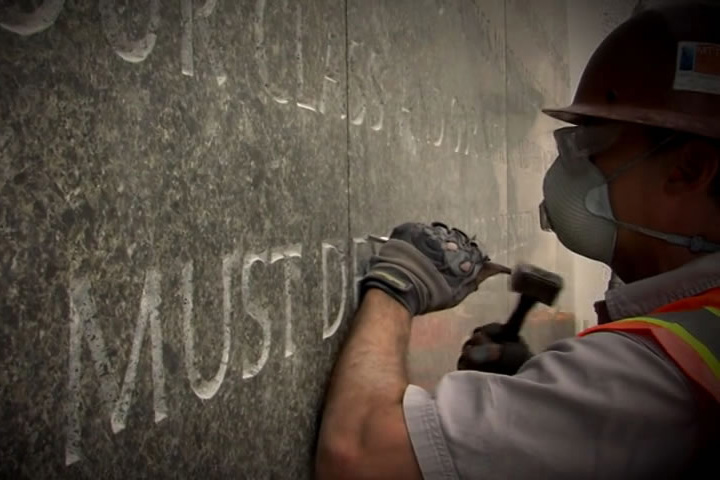A stone carver chisels a Roman capital letter in the surface of an expansive granite wall. His face obscured from view, all that can be gleaned over the din of his tools are the words of a narrator.
“They are carved in stone on the National Mall. Not the names of battles or the names of the dead, but the living words of an American who fought against injustice.”
That imagery and refrain open MLK’s Living Legacy, a documentary first screened in 2011 at the pre-dedication ceremony of the Martin Luther King, Jr. Memorial in Washington, D.C. The nine-minute film carries new weight today following the opening last fall of the Smithsonian National Museum of African American History and Culture and amid renewed debate surrounding documentary storytelling, authenticity, and place.
From the start of Living Legacy, audiences observe archival film footage of civil rights protests and riots—cars overturned in the streets amid shouting and picketing—as well as interviews with historians, policymakers, and others. It is just that blending of group and individual perspectives that lends the documentary its multilayered nuance.
“The stories that draw us in are those with characters who respond to a challenge and in whom we see a real transformation,” explains Stephen Menick, the film’s director and a Washingtonian.
That character in Living Legacy is a collective one, formed from a series of interviews that together ground a vision of individuals not content with the status quo and who choose instead to challenge the xenophobia that surrounds them.
One such voice is that of Dolores Huerta, co-founder of the United Farm Workers, who advocated during the King years for equal rights in the Southwest.

“What power do I have?” she recalls a worker asking her. “We convinced them that the power is in your person. This is a power that you have, and this is all the power that you need.”
A study of contrasts, Menick’s interviews with Huerta and others serve as a reprieve to its stirring and often unsettling footage. Together, the archival shots and first-person perspectives both enrich the film’s visual language and underline the power of individual voices in a society of stark contrasts.
“It’s these stories that need to be told now more than ever,” Michael Atwood Mason, director of the Center for Folklife and Cultural Heritage, wrote in a recent op-ed on the death threats his parents received for their support of King in 1965.
What this storytelling format offers is an intimate look at the tumultuous, and often painful, memories that would be lost if folded into a sanitized, third-person narrative.
Reflecting in Living Legacy on the first time she asked her parents about the Japanese internment camps in World War II, Karen Narasaki of the Asian American Justice Center shared one such stirring memory.
“My mother started to cry, and my father started to yell at me,” Narasaki recalls. “They were memories that they were really trying to suppress.”
Such a reflection, in another teller’s hands would be, at best, lost and, at its worst, broadly appropriated. It is only when filmmakers let individuals speak, rather than speaking for them, that deeper meanings emerge.
“When any minority starts to have a voice, that’s when things change,” Menick claimed.
It’s these stories, each endowed with an authentic point of view, that take audiences to new and otherwise unknown communities.

“Storytellers can transport you to different times and different places,” said John Franklin, director of programs and partnerships at NMAAHC, in his introduction to the 2009 Smithsonian Folklife Festival program Giving Voice: The Power of Words in African American Culture.
Franklin goes on to explain the power of transformative storytelling in African American communities. It is a format that weaves together individual voices, he explains, and one that runs counter to social divisiveness.
Living Legacy draws to a close with another shot of a stone carver, this time revealing his lettering as the façade of the MLK Memorial on the National Mall.
“We are not there yet,” Karen Narasaki adds in this final scene, referencing King’s harmonious vision, “but it’s the striving to get there that I think makes us American.”
Angelica Aboulhosn is the public affairs specialist at the Center for Folklife and Cultural Heritage.


